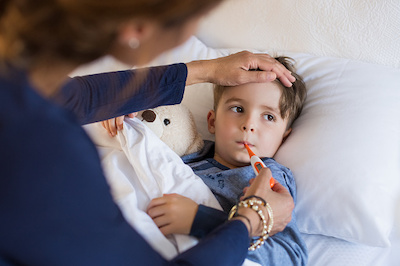 Yes, it’s cold and flu season — a time when young children may very well be passing germs between them. But how can you tell whether your child has a cold or the flu? Both are respiratory illnesses with similar symptoms. In general, symptoms are more intense with the flu than the common cold, but that can sometimes be hard to judge.
Yes, it’s cold and flu season — a time when young children may very well be passing germs between them. But how can you tell whether your child has a cold or the flu? Both are respiratory illnesses with similar symptoms. In general, symptoms are more intense with the flu than the common cold, but that can sometimes be hard to judge.
To help, the Centers for Disease Control and Prevention (CDC) has a symptom comparison chart. For example, symptoms of the flu tend to come on quickly, while common cold symptoms can come on more gradually. A high fever can be associated with the flu, but fevers are rare with colds; the same is true with chills, body aches and pains.
Part of what makes the situation especially confusing when trying to determine if it’s a cold or the flu is how some symptoms are reasonably common with both types of viral infections. For example, a stuffy nose, sneezing and a sore throat are typical common cold symptoms, but they are sometimes part of the flu. Although coughs and chest discomfort are common with the flu, this can also be part of a cold.
FamilyDoctor.org offers a more detailed compare-and-contrast about cold or flu symptoms.
Not Just One Common Cold—or Flu
To make matters more complicated, there are more than 200 types of viral infections that cause colds. There are fewer influenza viruses, although still multiple ones. Some can be especially serious, such as the H1N1 variety that’s sometimes called the swine flu.
When Your Child Should Stay Home
At what point should your child stay home from school or child care? If you know your child has the flu, they need to stay home and rest. According to WebMD.com, if your child has a fever of 101 degrees or more, then he or she should stay home until fever-free without medication for 24 hours. If your child is getting better but still wouldn’t be able to participate, it may be better for him or her to get more rest.
It can also be helpful to call the school or child care to ask about their policies.
When to Call the Doctor
If you have any doubts about how sick your child is, call the doctor. Besides the cold or flu, symptoms can be occurring because of strep throat or even pneumonia.
The article also suggests getting medical advice as soon as possible if symptoms are getting worse, or your child is having trouble breathing, seems confused, or has a bad headache. It can also make sense to call if your child’s sore throat lasts for more than a few days or is especially troubling.
When a high fever needs medical attention:
- Infants younger than 3 months of age: rectal temperature of 100.4°F or higher
- Older children with a temperature of 102.2°F or higher
Even if your child does not fit one of these categories but is acting in a way that concerns you, it can be better to call the doctor.
There is no test that can diagnose a common cold, but there is a swab test for the flu that provides results fairly quickly. The doctor may also decide to test for strep throat.
Treatment for a Cold or the Flu
Antibiotics don’t help with any viral infections, including the common cold or the flu. For a cold, your doctor may recommend Children’s Tylenol for body aches and pains and plenty of fluids and rest. A humidifier may help with a stuffy nose. For the flu, the doctor may prescribe one of the antiviral drugs, along with what’s recommended for a cold. Plus, here is a post that we created last year to help when your child gets the flu.
As a preventive measure, the CDC recommends a flu vaccine.




